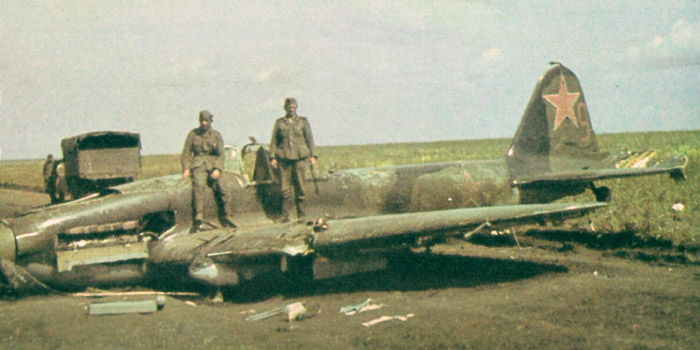Speaking of Il-2s built in the second half of 1941, after the traumatic beginning of the war, is to speak about planes built in Zavod 18; in facts, with the evacuation of Zavod 281 and the German capture of Zavod 35, Zavod 18 was the only one that continued to build this type up to the beginning of 1942.
There is not an unique version that can be defined as 'Il-2 type 1941 late', but a gradual evolution from the prewar style with (often) metallic rear fuselage, lowly-armored canopy, all-metal ailerons with four external balance weights, to the style of 1942 with (always) wooden rear fuselage, widely-armored canopy, new wing with fabric-covered ailerons and VYa-23 guns in outer position, and to the style of camouflage and markings that is fully representative of the year 1942.
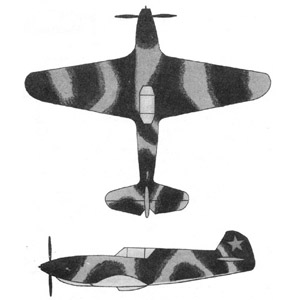 On
20 June 1941, the last day of peace, it was published an order of NKAP
(the Ministry for Aeronautical Industry) to paint all planes with a
new standard camouflage within one month.
On
20 June 1941, the last day of peace, it was published an order of NKAP
(the Ministry for Aeronautical Industry) to paint all planes with a
new standard camouflage within one month.
Already existing planes with uniform green uppersurfaces had to be added with matt black (A-26m oil paint for metal planes, and AMT-6 nitrocellulosic lacquer for mixed construction planes). Undersurfaces presumably preserved the original finish in A-18F or AII light blue.
For newly built planes, the instructions said to utilize matt light blue for undersurfaces (not specified what type of paint, but all previous light blue paintings were gloss, so they have to be A-28m for all-metal planes and AMT-7 for mixed construction planes).
Apart for some Yaks, the first known photos of planes with the new green/black painting scheme are dated to July 13, 1941.
Many maintenance manuals of the first years of war describe these paints: dope AMT-4 green, AMT-6 black and AMT-7 blue enamel or oil A-24m, A-26m and A-28m of the same colours. Oil colors were less utilized, also because AMT colors can adhere well to primed metal surfaces.
Despite their name (M= matt), AMT colors were semigloss when new, and turned to matt finish with ageing. Occasionally, they could have been overpainted with a layer of gloss varnish AB-4-d to improve aerodynamicity and gain some speed.
While AMT-4 and 6 were codified in July 1941, AMT-7 was codified in August 1941, and is not mentioned on earlier manuals; earlier AII light blue remained in use in parallel with the darker AMT-7 in the first years of war.
Oil enamels were intended to be sprayed on the exterior metal surfaces, even unprimed. Painting with a brush meant poor paint properties, and was allowed only as a second choice, ex. for repairs.
Prop blades were now fully painted black.
The order of June 1941 changed the national marks of planes too. Red stars, of plan type or with thin black outline, were now placed in four or six positions:
- one on each side of fuselage (not always),
- one on each side of rudder/stabilizer,
- one on the undersurface of each wing.
Note the deletion of stars over the wings, and the introduction of new ones on the tail.
Sometimes the stars were outlined with white, silver or yellow borders, but this wasn't a national standard; it could has been the factory mark of Zavod 18.
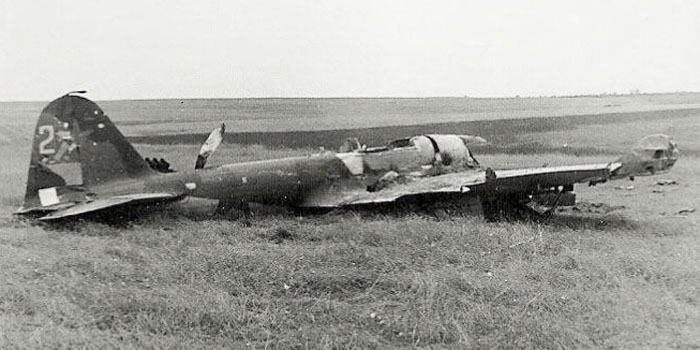
The first style of planes finished after the war's outbreak is recognizable in many photos of downed ones and wrecks, and is characterized by:
- metal rear fuselage and wings, as prewar planes (less frequently, wooden rear fuselage);
- early type canopy with reduced armor, as prewar planes;
- tall fuel tank;
- black-green camouflage;
- very large red star with black outline on the fuselage sides;
- small red star with black outline on the tail sides;
- very large red stars with black outline under the wings;
- no any red star on wing uppersurfaces;
- all-black propeller blades.
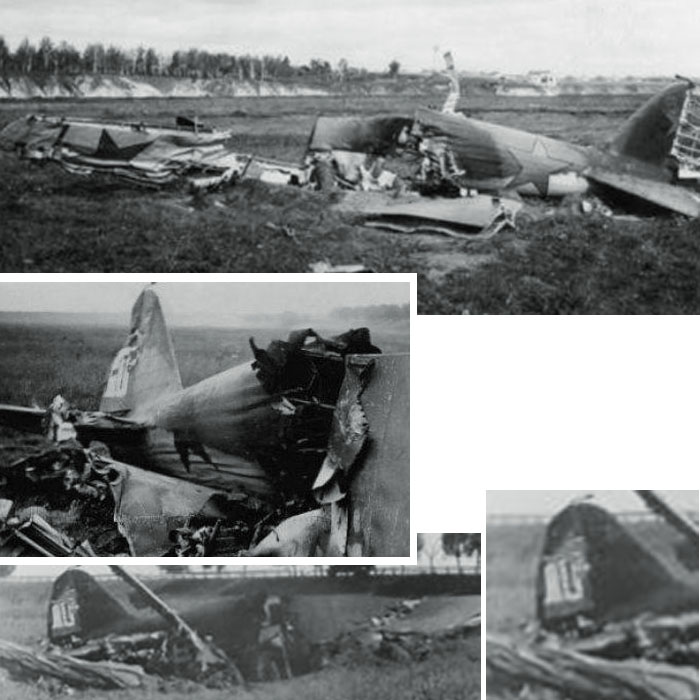
This plane 'white 10' was of 4 IAP; it could be the earlier Il-2 known with factory camouflage. The photos are of early July 1941.
The general characteristics are those written above, but the camouflage pattern doesn't find correspondance on other planes, and seems an improvisation. The fuselage seems metallic.

Photos of plane n.9 of 62 ShAP, built in Z.18, factory number 4711, engine number 01597, shot down on 8/23/41.
This one is widely documented by photos made by German soldiers, at least on its right side, but leaves still some doubts.
One is the look of the spinner: on some photos it appears uniformly light and matt. in one (the only one from the left) it appears to have a lighter tip, in other ones it appears dark and shining under some chipping mud.
Probably the light look is due to mood distibuted regularly because the propeller was still spinning when the plane was landing on the muddy ground.
On similar planes, usually the spinner conforms to the camouflage of the plane.
Plane n.9 has a metallic rear fuselage, and the style of the stars (very wide with black outline on the fuselage, very small with black outline on the tail) is very typical of July-August 1941.
The frames of the canopy appear painted with a lighter shade of green (probably A-19f) while the remaining part was probably repainted with AMT-4/6 just after the beginning of the war.
The lower surfaces appear too light to be compatible with AMT-7, so were probably painted with light blue A-18f or AII.
Below, a drawing showing a reconstruction of the look of white 9. The camoflage pattern on the left side was reconstructed with the help of photos of very similar planes.
An higher resolution version will be published with the book on Il-2 of Jason Moore.
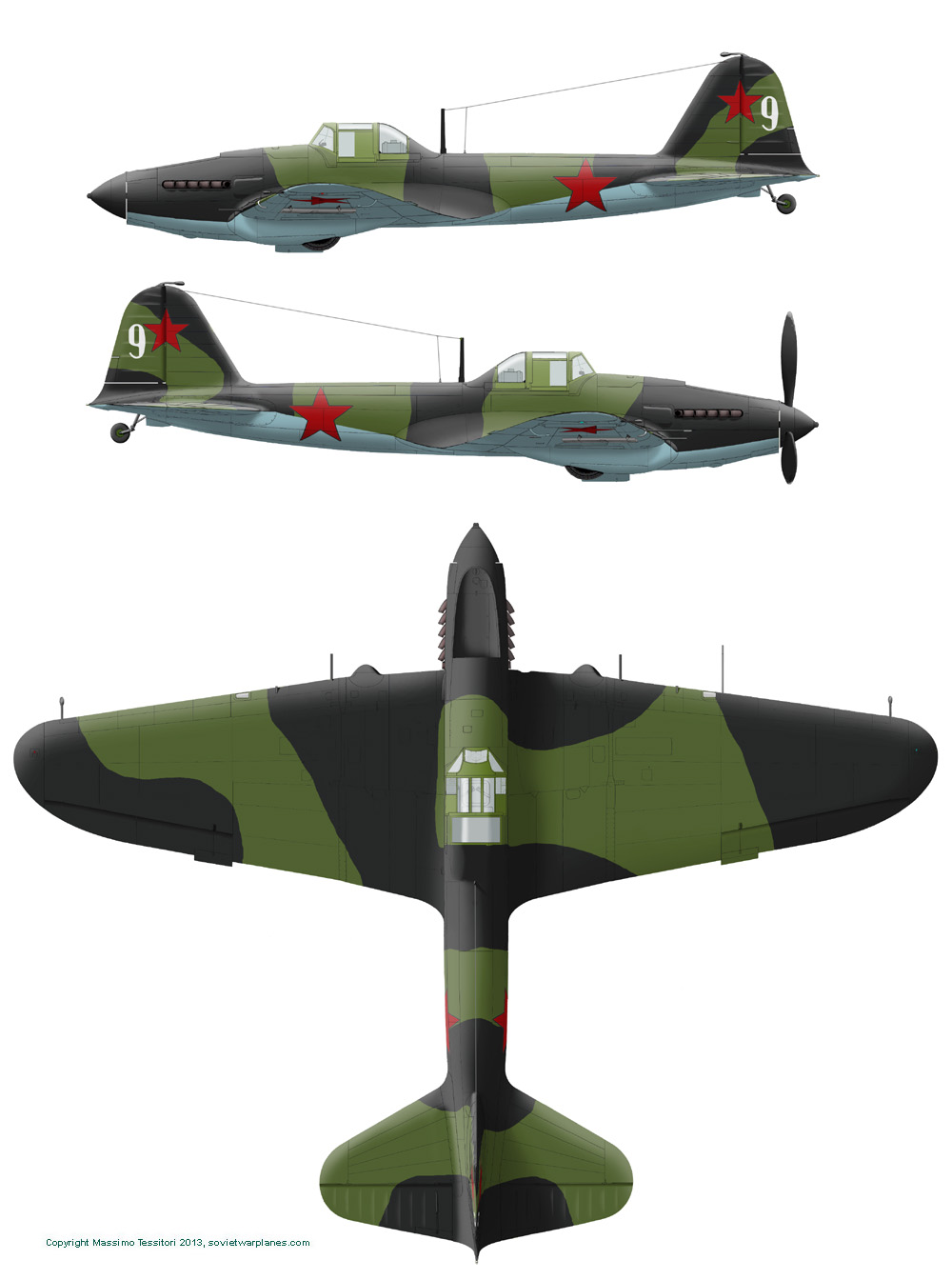
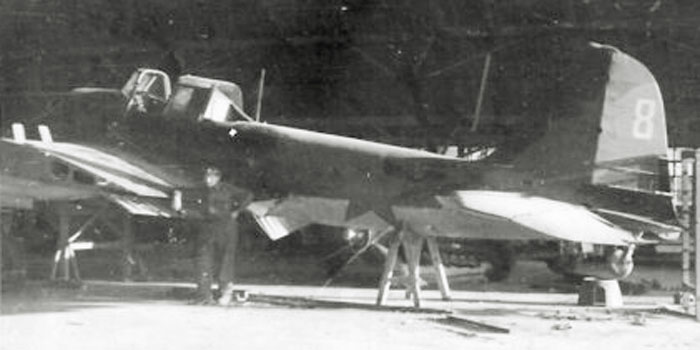
This look a variant of the same camo on another plane.
This one seems to have a wooden rear fuselage with some repairs and repainting close to the tail.
Other photos of planes and wrecks with similar colors and style of stars are known.
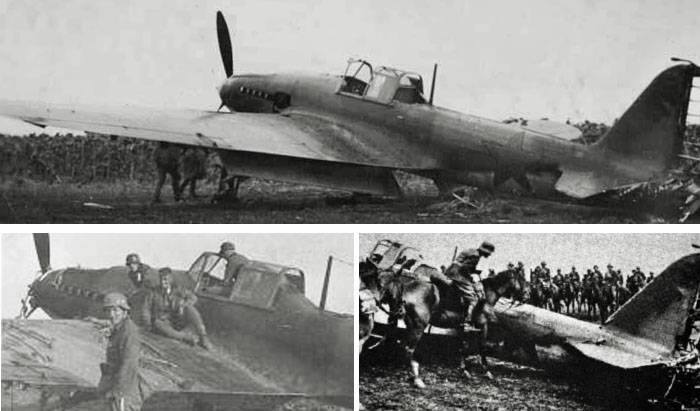
This plane, whose bort number is unknown, strongly resembles white 8 and 9, the main difference being the blurried camouflage.
The panelling of the fin reveals the metallic construction of the rear fuselage.
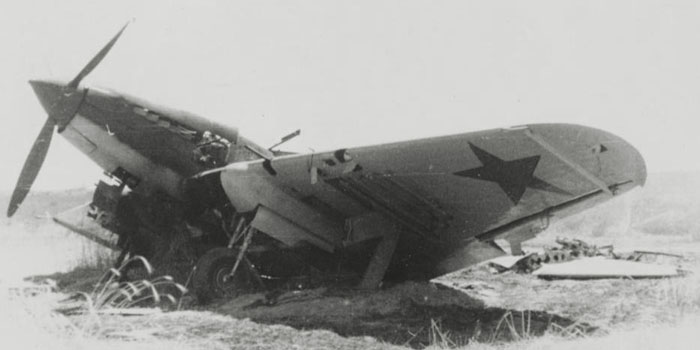
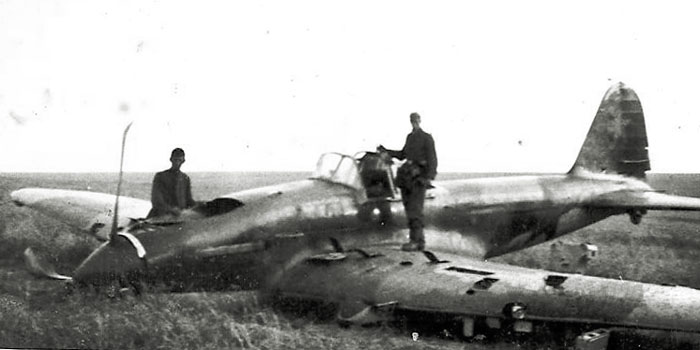
This Il-2 with metal fuselage shows the same style of stars of the previous ones, with a different camo pattern.
It's the same pattern utilized in 1942 and 1943 by factory n.30 that replicates carefully the NKAP template of 1941, with the characteristic large black 'balls', or 'mickey mouse's ears', on the fuselage sides.
Note the unpainted metal stripe covering the gap behind the spinner on the upper side. This protection usually was not installed on early Il-2s, in this case it is the result of a refitting.
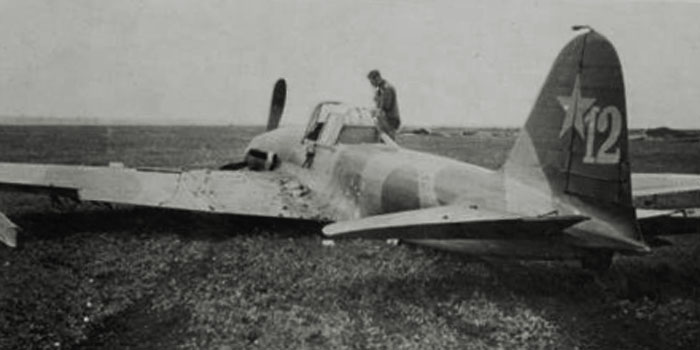
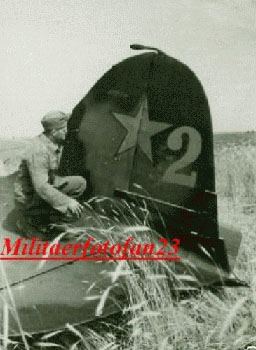 Red (?)
12 follows the camo pattern with 'balls', but it seems to have a metal
rear fuselage. The pattern is particularly sharp, and the characteristic
black balls on the fuselage sides are evident. The plane lacks of the
characteristic wide red stars on the fuselage sides.
Red (?)
12 follows the camo pattern with 'balls', but it seems to have a metal
rear fuselage. The pattern is particularly sharp, and the characteristic
black balls on the fuselage sides are evident. The plane lacks of the
characteristic wide red stars on the fuselage sides.
Right: the tail of another plane n.2. The camouflage is different, but the number looks executed with the same stencil of n.12, so probably the planes are from the same unit.
Below: a drawing of Red 12' made for the book on Il-2 of Jason Moore.
One can see the characteristic camo that was utilized by Zavod 18 only for a brief period, probably in July 1941, and was later resumed by Zavod 30 in 1942.
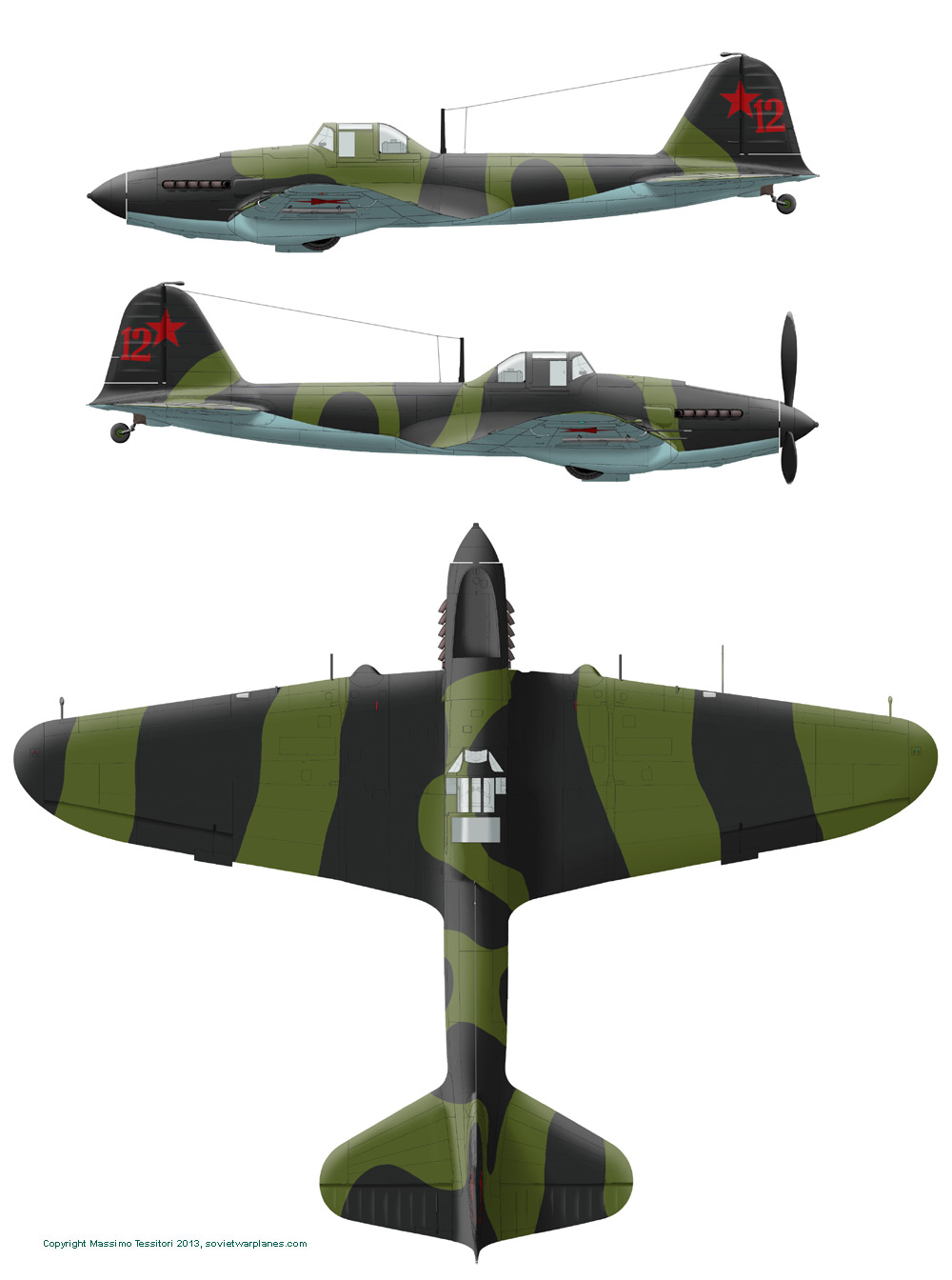
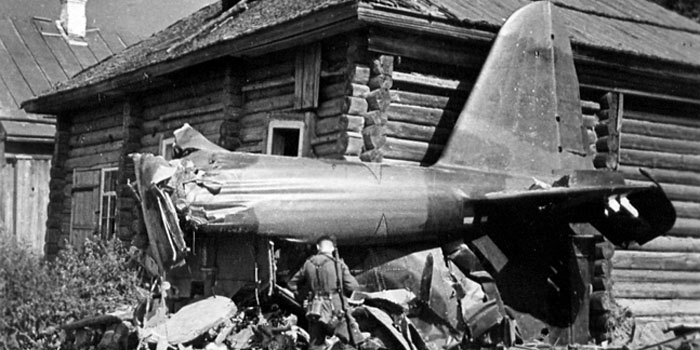
Another variation of the previous camo scheme is shown on this tail, that seems to be from a metal rear fuselage; probably it was built by factory n.18 with the prewar livery, and then repainted in some PARM (maintenance unit) to match the NKAP pattern of 1941.
Note the wide stars on the fuselage sides, absent on previous photos.
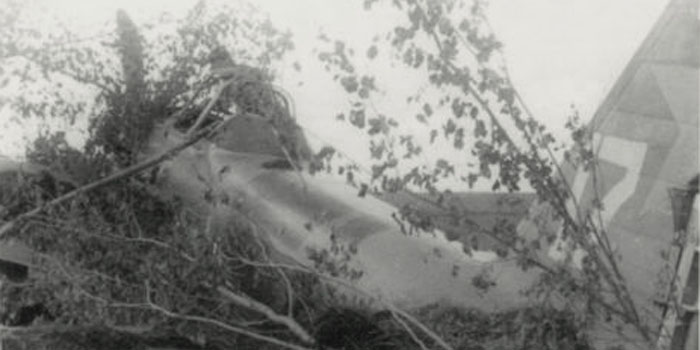
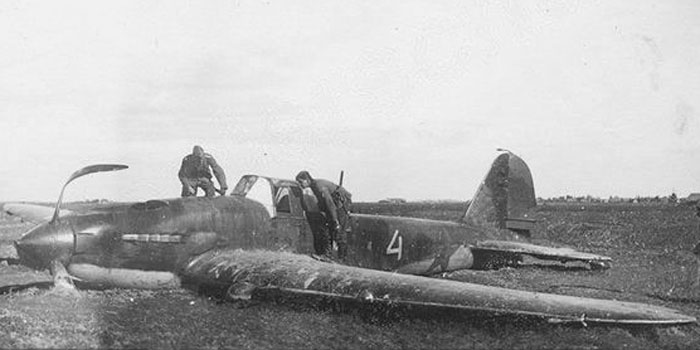
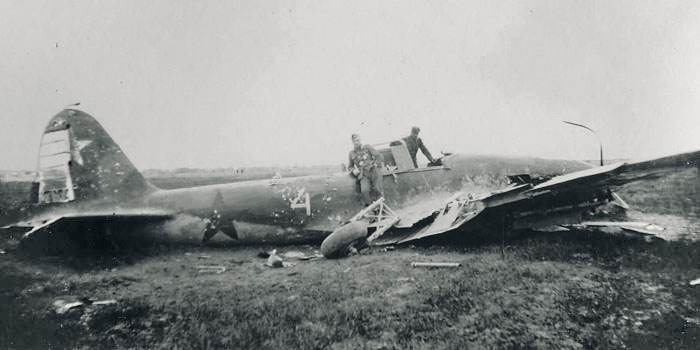
White 4 follows the 'big stars' style of markings and the pattern with side 'balls'.
The camouflage on the stabilizer seems modified with small light dots, but this could be a defect of the image, in facts light dots can be seen on the shadow under the horizontal tail surface too, and this is clearly a defect.
Strangely, the tail star appears dark on the photo above, but it seems very light on the photo below (and on another one from the left).
This is hard to explain, possibly the stars were made with different shades of red and this is put in evidence by some films.
As an alternative, the fabric skinning could have been carefully cutten away by a souvenir hunter, leaving the underlying yellowish putty.

A drawing of White 4.
Click on the profile to see a larger 3 views drawing.
An higher resolution artwork will be published into the book on Il-2 of Jason Moore.
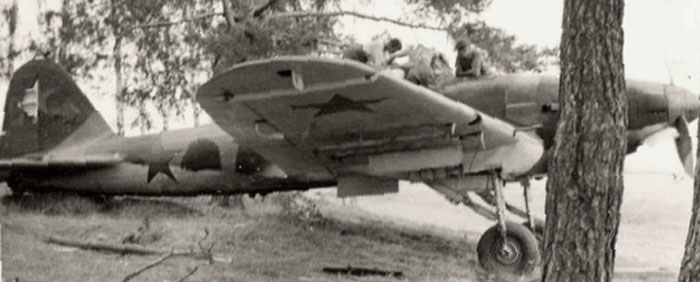
The same camo is clearly recognizable in this photo. The plane looks to have a red 6 on the rudder.
The image is interesting for the details under the wing, in particular for the balance weight under the ailerons.
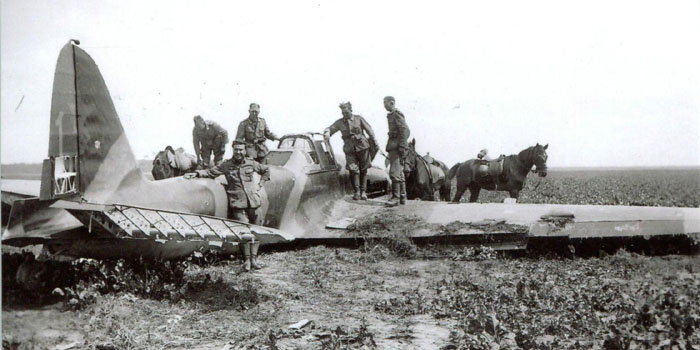
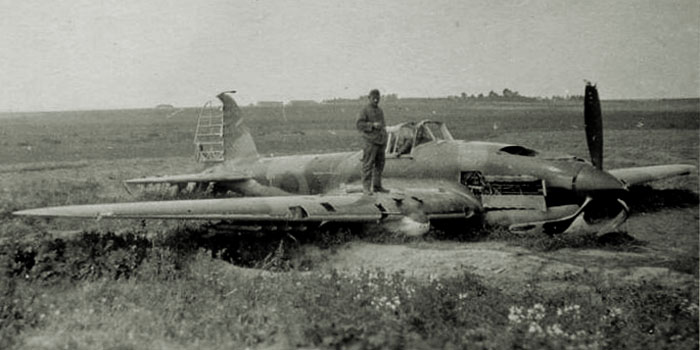
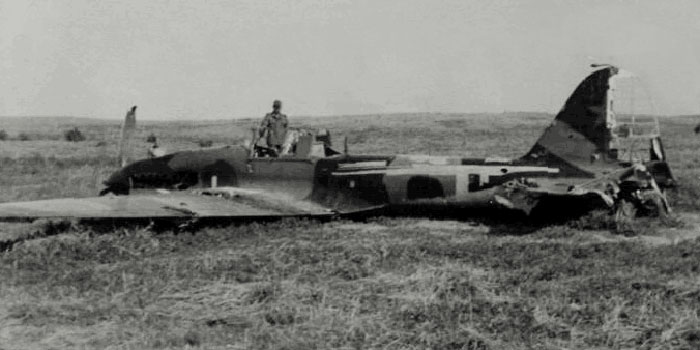
Il-2 n.1 (yellow?) is one of the best documented wrecks by German photographers in late summer 1941.
On a photo, the serial 2304 can be read on the front of a nacelle, but doesn't help to understand if this is a plane of Z.18 or what else.
Similar in many respects to the previous ones, this plane seems to feature a wooden rear fuselage. The stabilizer is a bit undulated and could create the impression of a metal skinning, but the fuselage is clearly wooden : German souvenir-hunters have removed parts of the skinning, leaving to see the yellowish color of the putty for wood.
This plane looks without the fuselage star, just as red 12 that has a metallic rear fuselage.
Thanks to Vitaliy Timoshenko
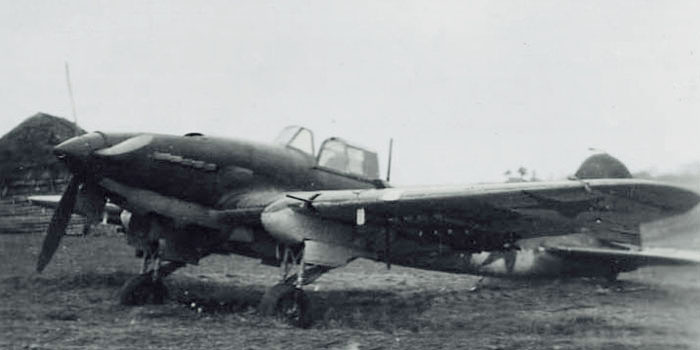
Many photos of German origin show Il-2s with white bands around the red stars on fuselage and wing undersurfaces. Probably all them belonged to the same unit.
Them all appear as the typical production of Zavod 18 of the summer 1941, with metal rear fuselage, metal wing of 1941 and canopy with reduced armor. The only new constructive characteristic we see is the thin sheet cover over the gap between spinner and cowling.
This one was c/n 1834612.
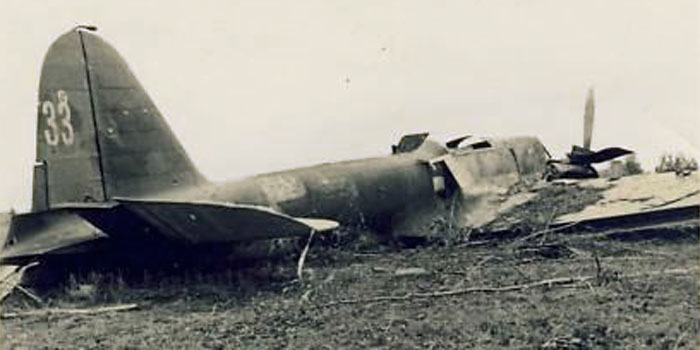
One of the planes with the white bands was White 33 (s/n 1862213 head number 1862213, engine number 0210); the pilot was lieutenant I.G.Kiryuhin, shot down on 08.09.1941.
We see that it has a later pattern of camouflage of Zavod 18, characterized by an horizontal undulated band on the tail, large stars with black outline on the fuselage, small star with black outline on the tail.
A drawing of White 33.
Click on the profile to see a page with further photos and a larger 3 views drawing.
An higher resolution artwork will be published into the book on Il-2 of Jason Moore.
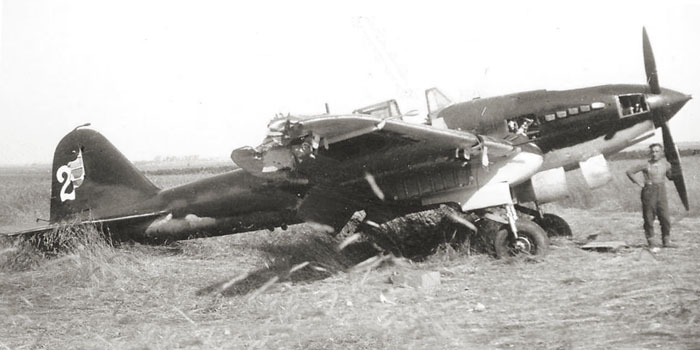
This Il-2 looks repainted with black bands on the base of the prewar green painting (note the glossy colors). The shape of the lacking fabric on the rudder suggests that there was a red star, although not contrasting on the rudder. It seems that the red star under the wings was cutten away too.

White 7 has still some archaic characteristics as the unarmored canopy and the flexible boot on the tail wheel, but shows already the style of markings that became representative of the production of Zavod 18 from the fall 1941 to the summer 1943: a thin white outline around all the stars, including those on undersurfaces. Now the fuselage stars were relatively small and close to the tail. Note the white tip of the spinner.
The camo pattern is not easily recognizable, probably it's the one with an horizontal z-shaped black band on the tail.
It's unclear if it had the wooden rear fuselage, as I guess.
Note the unusual bended mast. It is unclear if it's inclined backwards, or is moved on the left side of the fuselage as the few planes that received externally-mounted ShKAS in an attempt to defend the planes from the rear.
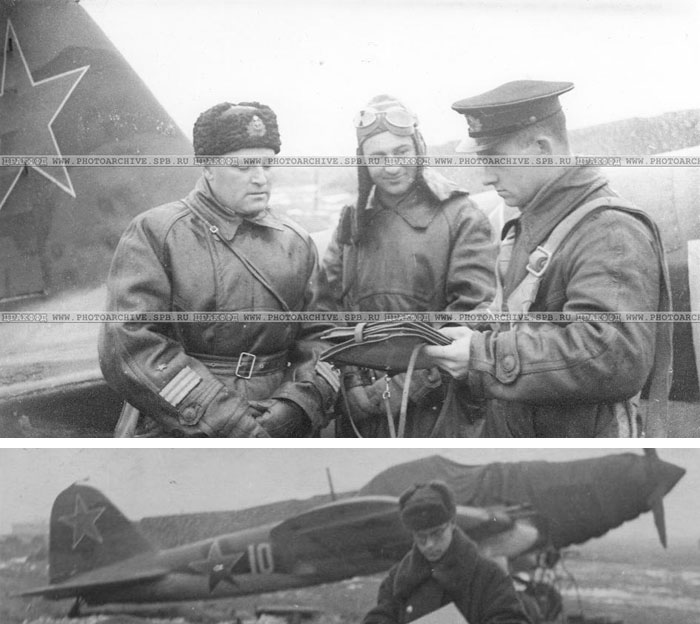
N.G.Stepanyan, 57 PShAP of Red Banner Baltic Fleet (KBF) at the Leningrad airport in November 1941.
http://www.warheroes.ru/hero/hero.asp?Hero_id=263
Around him, G.S.Nelson and Potapov.
Below, an image of his plane n.10. This seem built in Z.18 around September 1941. It has a wooden fuselage (but we see a repair close to the star fixed by small nails), unusually large red stars with white outlines and a sharp camouflage with an horizontal band on its tail. The canopy is likely of the early style.

A drawing of Stepanyan's 10. Where not visible on the photo, the camouflage was drawn as a mix of similar planes.
Click on the profile to see a larger 3 views drawing.
An higher resolution artwork will be published into the book on Il-2 of Jason Moore.
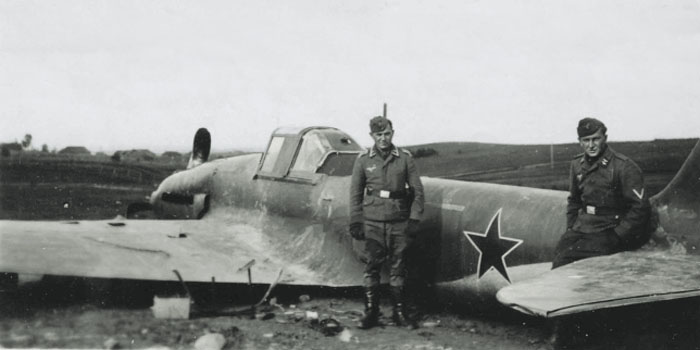
A downed plane with the new style markings. The sliding hood is still with reduced armor, but an additional armor was added behind the canopy. It has still the single armorglass behind the pilot's head.
The rear fuselage is clearly wooden; we see some stripping of the external fabric skinning, leaving a rectangular part where the yellowish color of the putty for wood is visible.
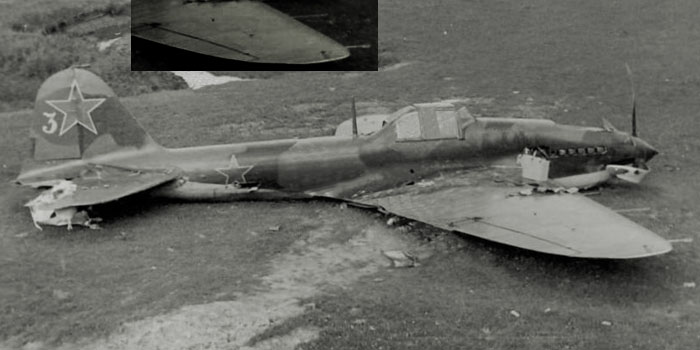
White 3 has the new style of marks of Zavod 18 and the briefly-used camouflage with the horizontal band on the tail, but its rear fuselage looks still of the metallic type. The rudder looks from a different plane.
The sliding hood is still with reduced armor, but an armor plate looks added on the back of the canopy.
In the small window, a darkened detail of the wing where the camo is barely visible.
A drawing of White 3.
Click on the profile to see a larger 3 views drawing.
An higher resolution artwork will be published into the book on Il-2 of Jason Moore.

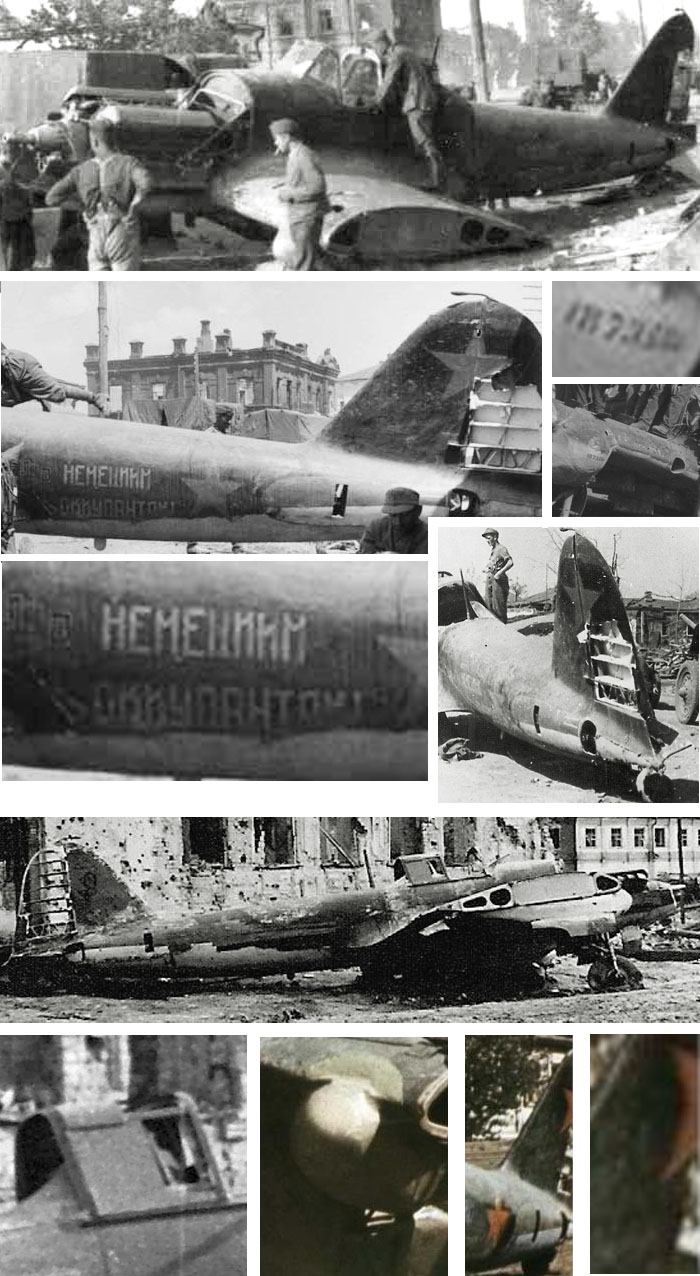
A wrecked Il-2 in the streets of Ostrogozhsk, in Voronezh area; this town was occupied by German troops from July 1942 till January 1943.
The number on the nacelle is partly readable and suggests a plane built in Z.18 in August/September 1941; seems that the typical thin white outlines of Z.18 weren't yet in use at that time. The wing had to be of early type with 20 mm ShVAK, but the armour on the canopy is of the late type.
The most interesting thing of this wreck is the slogan SMERT' NEMECKIM OKKUPANTAM which stands for 'Death to German invaders'; 'Smert' is hardly readable, seems written obliquely and with the inner part of letters in red.
It seems that there is a very tiny 8 painted close to the stars on the tail.
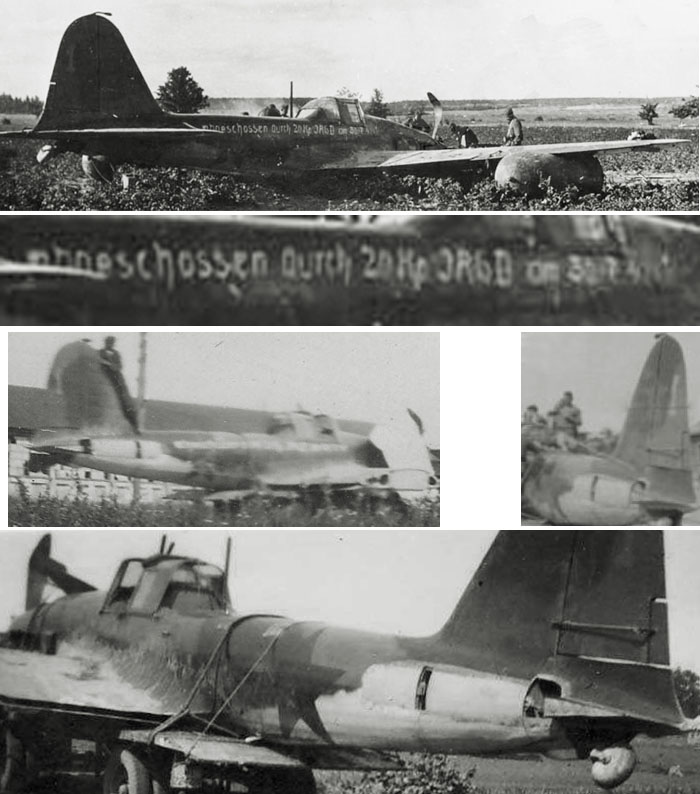
Images of a downed plane recovered by Germans.
One can read the inscription made by Germans on the right side: abgeschossen durch 20 Kp JRGD om 30 7 41 that means 'shot down by 20 Kp JRGD on 30 7 41'.
The plane is a plane with wooden fuselage, probably of prewar production. The small stars on the tail and wide stars on the fuselag, probably with black outline, are very typical of the Il-2s built or repainted in the first two month of war.
The camouflage is of difficult interpretation because it includes at least three shades of color, but perhaps more, as clearly visible on the photo aside. The number is of a color lighter than red, but darker than the light blue of the undersurface; it could be yellow or blue.
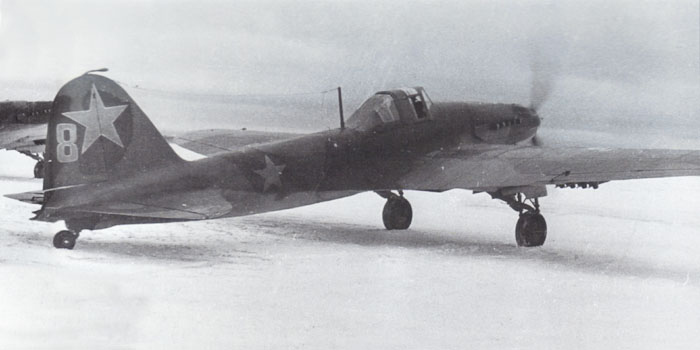

Two photos of red (?) 8 of 174 ShAP on October 30, 1941.
The plane has a fully armored sliding hood, perhaps a refitting; the rear of the canopy is fully trasparent, but the central part looks protected with a narrow armour, probably a refitting; inside the windows, one can see the large armorglass behind the pilot's seat and the MV-1 gunsight.
The stars have thin white outlines as usual for the planes built in Z.18, and the camouflage is similar to their classic one, but made more complex by some more small black spots on the tail and green spots (or repaintings) on the wings.
The spinner's tip is coloured, probably in light blue. The rear fuselage is wooden, while the wings are likely of the 1941 type with 20 mm ShVAK guns.
Top image: Red Stars of Geust, Keskinen, Stenman, ed. Apali;
image below: photoarchive.spb.ru, via V.Timoshenko.

A reconstruction of Red 8 of 174 ShAP.
Click on the profile to see a larger 3 views drawing.

White 19 of 174 ShAP . The sliding hood looks strange, as if it was an early one with an armoured band on its front.
The camouflage looks compatible with the one of Zavod 18, apart for the tail vertical surface that has a fully atypical black contour.
It's likely that the plane had the front of the spinner painted red, as other ones of the same unit.
(From Il-2 in action-Squadron Signal)

A drawing of white 19.
Click on the profile to see a larger 3 views drawing.
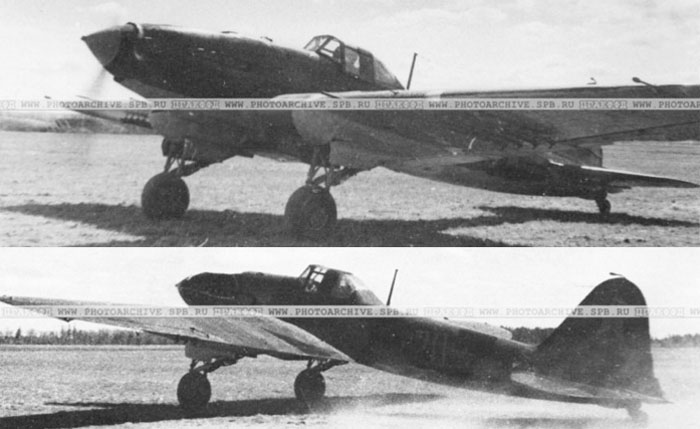
Plane n.20 of 174 ShAP on the Central Front, in 1941 (probably in the late summer). It seems to have resemblance to n.19 and 8 of the photo above.
The plane has the metal wing of 1941; the photo shows the balance weight at the wingtips, but not under the ailerons; this probably means that fabric-skinned ailerons were introduced before the adoption of the wing with VYa-23 guns (here referred as 'type 1942 wing').
The plane shows still the complete glazing behind the canopy, the armorglass behind the pilot's head and the small armour plates on the sides of the sliding hood, but there is already the armour plate above the sliding hood.
About the painting: the camouflage is unclear, but looks an early variant of Z.18, perhaps with the horizontal band on the tail. A (white?) number 20 is painted on the fuselage; the front of the spinner looks painted in light color (red or blue?), with a thin white outline to divide it from the rear part that was black.
Images photoarchive.spb.ru via Vitaliy Timoshenko
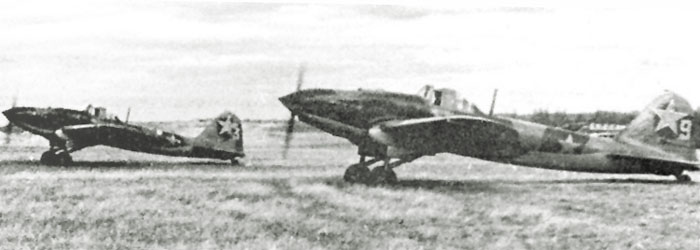
Planes n. 3 and 9 of 217 ShAP on the Bryansk front; according to the caption on the book of Rastrenin, they were photographed in August 1941, but I guess that this modification could be a bit later. The sliding hoods appear of late type, with upper armor and reduced side windows, but no any armour is visible on the back of the canopy. Both planes have the flexible boot on their tail wheel.
The camouflage with black amoebas on the tail and white outlined stars is typical of Zavod 18 between the late summer/fall of 1941 and the summer 1943.
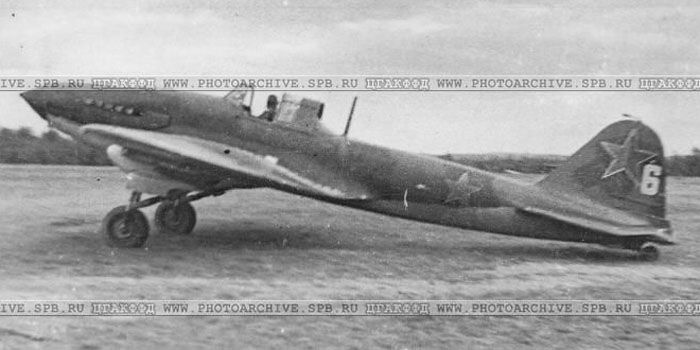
Plane n.6 resembles very much to the couple of planes above.
Image from www.photoarchive.spb.ru via Vitaliy Timoshenko
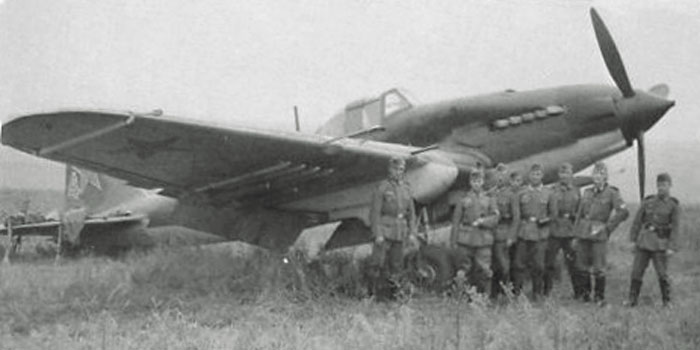
Red 4 with white outline has a sliding hood with armor on its top, but still the large side windows. Probably it has back armour too, and armorglass at the pilot's shoulders.
It looks the classical pattern of Zavod 18 of late 1941, with a black amoeba on each side of its tail.
The wing is still of the metal type with a ShVAK gun in inner position and a ShKAS outside, and landing lights on both the wing leading edges, but there are balance weights only at the wingtips, not under the ailerons; perhaps the ailerons were of fabric-covered type as on later planes.
The plane has not to be confused with another Red 4 with white outline captured intact and remarked by Germans, but with the later style of wings and the number in a different position.
A rare color photo represents a downed Il-2 with unusual painting.
The plane is produced in Zavod 18 presumably in mid 1941just after the war's outbreak; it features the early type metal wing; the fuselage is already of the wooden type, and it seems that the canopy is still of the type with reduced armor.
The base camouflage is very worn and scarcely contrasting, and bears traces of a badly removed winter paint, and this suggests that the photo was taken in 1942. Even the star on the fuselage appears in such conditions, while both the star and the black bands on the tail and rear fuselage were repainted.
The color of the spinner, after the chromatic corrections to the image, looks similar to that of the grass, and could be light green A-7. It is difficult to say the color of the number: it seems a dark yellow.
An interpretation of n.9.
Click on the profile to see a larger 3 views drawing.
An higher resolution artwork will be published into the book on Il-2 of Jason Moore.
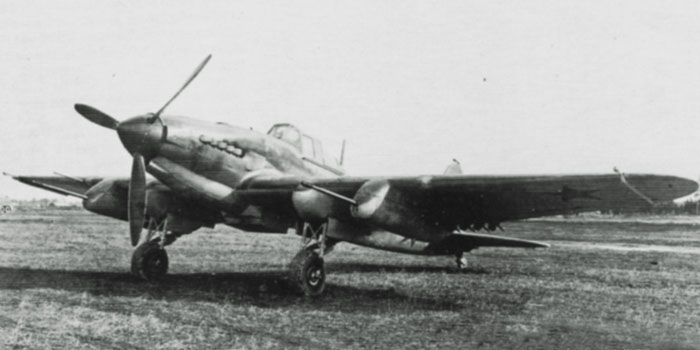
An Il-2 armed with ShFK-37 37 mm guns was built in late 1941 and even tested in combat, but the results were unsatisfactory because of the increase in weight and the lack of precision due to the strong recoil.
The plane features:
- wide underwing nacelles for the guns and their magazines
- early style metal wing without the ShKAS and ShVAK armament
- early style canopy.
Unfortunately the photo doesn't reveal much on how the plane was painted.
(From Ilyushin Il-2 by Oleg Rastrenin)
An interpretation of this plane.
Click on the profile to see a larger drawing.
An higher resolution artwork will be published into the book on Il-2 of Jason Moore.
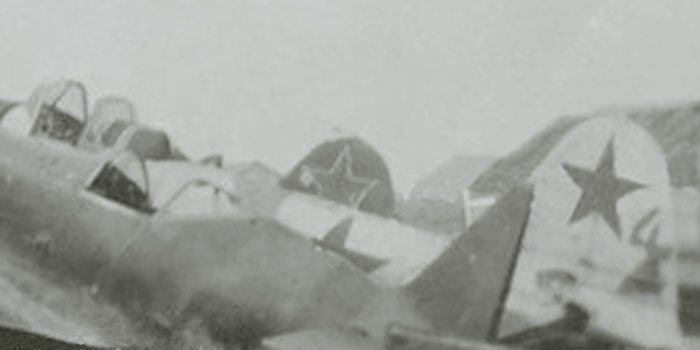
Partial photo of a rare wreck of Il-2 built in mid 1941 with a winter livery.
Note the vaguely visible paneling on the tail, revealing a metallic rear fuselage, and the rear armourglass behind the seat.
The very large red star on the fuselage and the small one on the tail are typical of planes built, or repainted, in summer 1941.
The white livery looks regular even in spring, as if it was made with permanent paint.
An interpretation of red 4.
Click on the profile to see a larger 3 views drawing.
An higher resolution artwork will be published into the book on Il-2 of Jason Moore.
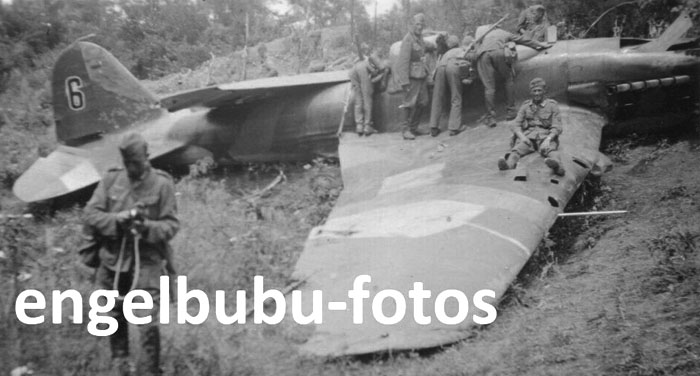
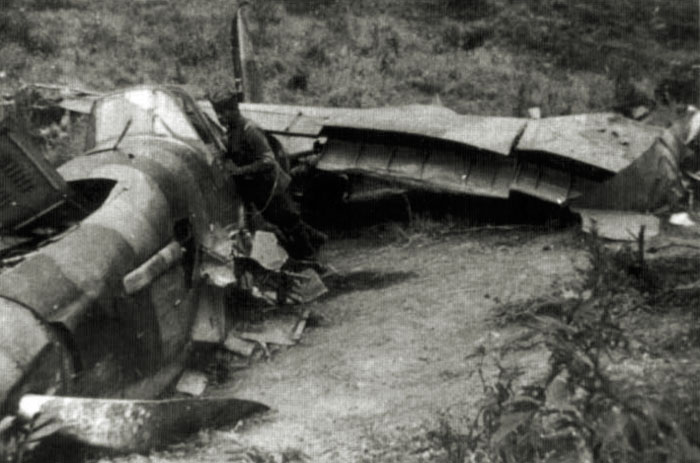
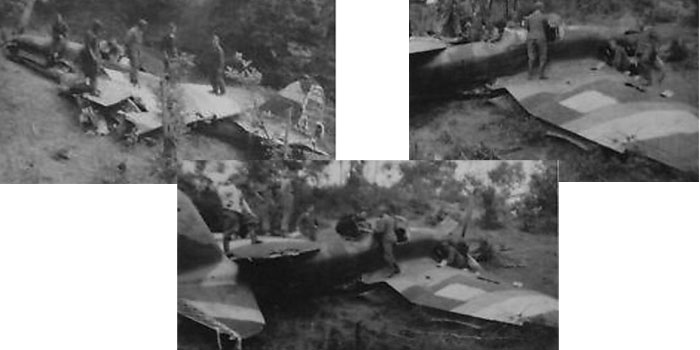
Single-seater Il-2 'black (?) 6' shot down probably in 1942, clearly showing a non-standard 3-shades camouflage, or perhaps a partial winter scheme, on the base of the prewar green-blue livery.
Very few is visible of this plane, but it seems of pre-war production without the star on the tail and without the 'lip' covering the junction between cowling and spinner.
Despite the availability of many photos, the markings, some characteristics of this plane are still unclear.
(Images from the web and from Il-2 In action of Squadron-Signal)



